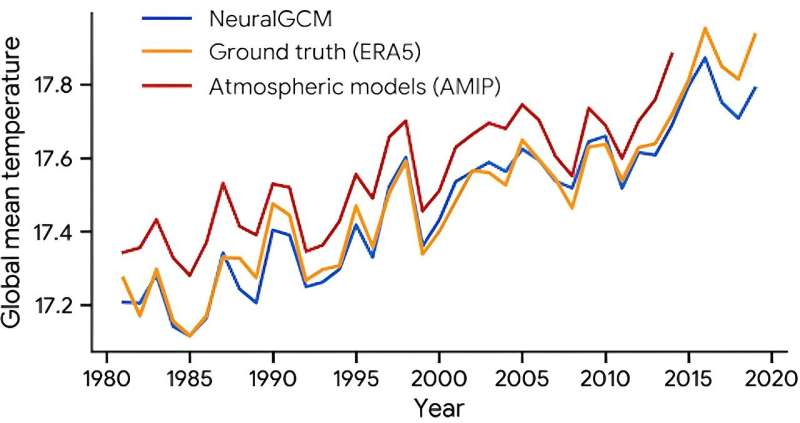A new system for forecasting weather and predicting future climate uses artificial intelligence (AI) to achieve results comparable to the best existing models while using far less computing power, according to its creators.
In a paper published in Naturea team of researchers from Google, MIT, Harvard and the European Center for Medium-Range Weather Forecasts say their model offers huge “computational savings” and can “improve large-scale physical simulations that are essential for understanding and envisioned the Earth system.”
The NeuralGCM model is the latest in a steady stream of research models that use advances in machine learning to make weather and climate predictions faster and cheaper.
What is NeuralGCM?
The NeuralGCM model aims to combine the best features of traditional models with a machine learning approach.
At its core, NeuralGCM is what is called a “general circulation model”. It contains a mathematical description of the physical state of the Earth’s atmosphere and solves complex equations to predict what will happen in the future.
However, NeuralGCM also uses machine learning—a process of finding patterns and regularities in large amounts of data—for some less well-understood physical processes, such as cloud formation. The hybrid approach ensures that the output of machine learning modules conforms to the laws of physics.
The resulting model can then be used to make weather predictions days and weeks ahead, as well as look months and years ahead for climate forecasts.
The researchers compared NeuralGCM to other models using a standardized set of forecasting tests called WeatherBench 2. For three- and five-day forecasts, NeuralGCM did about as well as other machine learning weather models like Pangu and GraphCast. For longer-range forecasts, over ten and 15 days, NeuralGCM was as accurate as the best existing traditional models.
NeuralGCM was also quite successful in predicting less common weather phenomena, such as tropical cyclones and atmospheric rivers.
Why machine learning?
Machine learning models are based on algorithms that learn patterns in the data they are fed, then use this learning to make predictions. Because climate and weather systems are very complex, machine learning models require large amounts of historical observations and satellite data for training.
The training process is very expensive and requires a lot of computing power. However, once a model is trained, using it to make predictions is fast and cheap. This is a large part of their appeal for weather forecasting.

A comparison of how NeuralGCM compares to leading models (AMIP) and real data (ERA5) in capturing climate change between 1980 and 2020. Credit: Google Search
The high cost of training and low cost of use is similar to other types of machine learning models. GPT-4, for example, reportedly took several months to train at a cost of more than US$100 million, but can answer a question in moments.
A weakness of machine learning models is that they often struggle in unfamiliar situations—or in this case, extreme or unprecedented weather conditions. To do this, a model must be able to generalize, or extrapolate beyond the data it was trained on.
NeuralGCM appears to be better at this than other machine learning models because its physics-based core provides a basis in reality. As Earth’s climate changes, unprecedented weather conditions will become more common, and we don’t know how well machine learning models will hold up.
No one is using machine learning-based weather models for day-to-day forecasting yet. Still, it’s a very active area of research—and one way or another, we can be sure that future predictions will involve machine learning.
Provided by The Conversation
This article is republished from The Conversation under a Creative Commons license. Read the original article.![]()
citation: AI-Powered Weather and Climate Models Set to Change Future of Predictions, Researchers Say (2024, July 28) Retrieved July 28, 2024, from https://phys.org/news/2024-07-ai- powered-weather- climate-future.html
This document is subject to copyright. Except for any fair agreement for study or private research purposes, no part may be reproduced without written permission. The content is provided for informational purposes only.